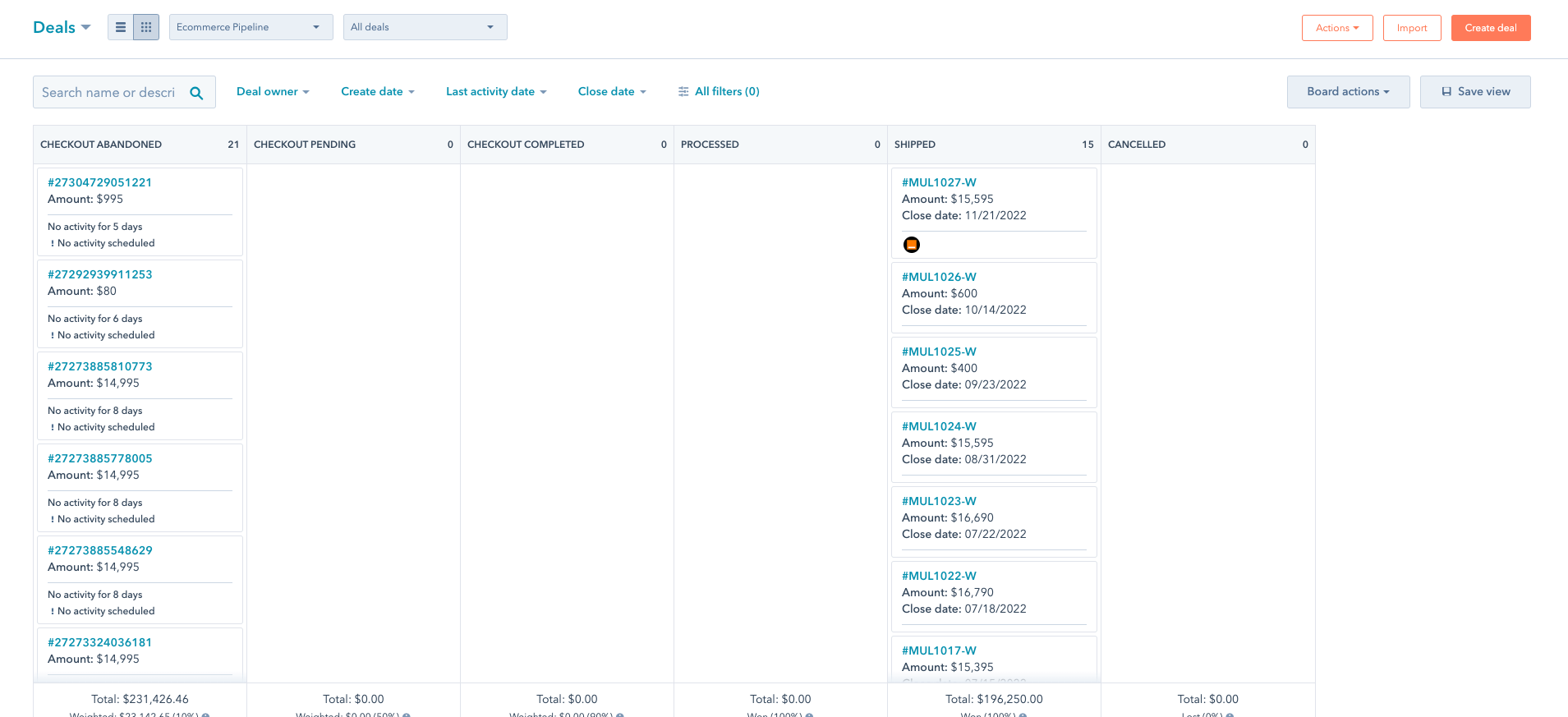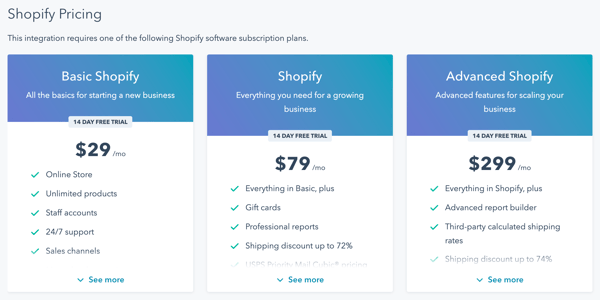
Do you use Shopify to sell your company’s items online? Do you also use HubSpot for marketing, revenue, and/or support? Properly, if you have not nevertheless set up the HubSpot Shopify integration, you are lacking out on very practical insights and information that could include to your company’s bottom line.
This posting addresses the attributes and rewards waiting around for B2B brands, a lot of of which commonly underutilize ecommerce. Furthermore, you’ll see illustrations of what you can do with the integration as it pertains to complex B2B brands.
What is the HubSpot Shopify integration? Why need to B2B makers care?
You can promptly and conveniently hook up your Shopify Seller account to your HubSpot CRM by making use of the HubSpot Shopify integration. This produces a different Offers pipeline in HubSpot Revenue Hub named “ecommerce” that pulls precious information and facts about sales, abandoned carts, and pending checkouts into your HubSpot CRM.

Obtaining this information in your CRM effects in quite a few benefits that we’ll unpack beneath — which includes currently being able to use shopper information for electronic mail campaigns, promoting automation, reporting, and more. Only place, it is impressive B2B ecommerce for suppliers that should not be missed.
How do I established up the HubSpot Shopify integration?
Putting in the Shopify integration in your HubSpot portal is actually as easy as logging in and turning it on.
At the time you have signed into your Shopify account and built-in it with your HubSpot account, switch on 2-way sync to mail data back and forth in between the two platforms.
Here’s what you’ll see:
- Promotions will now immediately be developed in your HubSpot ecommerce pipeline whenever any individual on your Shopify store completes some data in a cart. Experiences exhibit you how a lot revenue is sitting down in abandoned carts, or pending, or has been delivered, etcetera.
- Your HubSpot tracking code is now mounted on your Shopify webpage, which syncs your make contact with info from HubSpot into Shopify. So, if an present HubSpot call goes to your Shopify account, you are going to know about it and see that they have an ecommerce offer. Moreover, contacts are quickly imported from Shopify to HubSpot as they comprehensive cart information and facts.
- For present/repeat shoppers, their contact file in HubSpot will demonstrate Shopify attributes like the amount of revenue they’ve expended with you, their normal order, 1st date of purchase, objects they buy, and extra.
Is the HubSpot Shopify Integration Totally free?
The integration calls for that you have at minimum a Shopify Basic Seller subscription approach ($29.99 for every month), but there is no supplemental demand from HubSpot or Shopify to facilitate the integration.

8 ways the Shopify HubSpot integration enhances marketing, profits, and buyer service
We alluded to it above, but there are quite a few chances for B2B suppliers who are conducting ecommerce to leverage Shopify information in your advertising, product sales, and shopper support. In this article are eight that stand out to get your wheels spinning:
1. Fix abandoned carts
Let’s begin with maybe the most significant opportunity… An abandoned cart means your prospect was interested in obtaining your solution, but stopped just ahead of obtaining! These persons are significantly more likely to purchase in the upcoming than a cold direct.
Utilizing HubSpot workflows, you can enroll anybody who abandons a cart in Shopify into a targeted e-mail marketing and advertising marketing campaign in which you are going to remind them of reasons they had been fascinated in the 1st location. This basic workflow continues to construct value in your item whilst the product(s) sit in their cart.

2. Deliver exclusive gives
Surveys tell us that the most important purpose for an abandoned cart is unanticipated fees, this sort of as delivery. So, in your electronic mail promoting workflow, include both a low cost on (or a coupon for) free transport.
If this is monetarily feasible for you, it is normally adequate to lure the shopper back again to your web-site. Due to the fact this is a collection of e-mails, you can attempt to drive a invest in without the provide first and save the provide for later on in the sequence.
3. Improve or maintenance on formerly acquired items
Applying segmentation in HubSpot CRM dependent on Shopify purchase homes, you can create lists and ship e-mails to people who have ordered a particular item.
As soon as a new variation of that merchandise is obtainable, or a new company associated to that invest in is introduced —replacement components or regimen routine maintenance that desires scheduling, for example — ship an e-mail to that record. The email ought to reference that prior invest in to develop additional desire and travel revenue.
4. Build targeted lists
Think about what you manufacture. Can you section people today into teams primarily based on the style(s) of products they acquire? Generate sensible lists in HubSpot centered on these buys.
Here’s a simplified instance: Apple has a single listing of individuals who ordered laptops, and another record of people who ordered phones.
- Interact the men and women on the “laptops” record with a workflow that promotes add-ons to Apple computer systems (observe, mouse, keyboard, charger, and so forth.)
- Engage the “phone” checklist persons with a workflow that promotes cell phone extras (situation, headphone, charger, display screen protector, etc.)
5. Prioritize Product sales group exercise and access out specifically
For massive-ticket merchandise like purchases of significant equipment, it is well worth the work to have your Profits workforce reach out straight to abandoned carts. In HubSpot, generate a checklist that segments deserted carts by deal amount dependent on a threshold that tends to make perception (i.e. warrants your team’s immediate interest). Then bring about a Sales sequence of responsibilities and link try electronic mail templates to notify your group that observe-up is wanted.
For case in point, all deserted carts $3,000+ enter a workflow that notifies a product sales rep of a new member of the record. That rep reaches out right to the get in touch with by using e-mail or telephone in an try to aid shut the offer. And mainly because of the integration, not only the contact’s web site website page activity is recorded on their get in touch with history in the HubSpot CRM, but any Shopify exercise they took is obtainable to the rep for context as properly.
6. Include HubSpot pop-up forms
A HubSpot popup form can be populated by list membership. Any call on the record who lands on a distinct webpage (you pick out which kinds) sees a popup kind selling a product or service they abandoned, or even a product or service that’s comparable to a little something they previously acquired.
7. Build reporting dashboards demonstrating ecommerce information and facts
Dashboards are a single-site overviews in HubSpot and generating an ecommerce Dashboard can present a rapid appear at your Shopify keep general performance. It’s easy to track and overview every month revenue, the percentage of deals that close, amount of abandoned carts, and considerably a lot more.
8. Enhance shopper support
We have lengthy been proponents of 360º use of the HubSpot CRM — meaning internet marketing, income, and services teams function from a solitary source of truth for all of their interactions with potential clients and buyers. This is no various with Shopify details. In fact, the CRM gets to be even much more highly effective when genuine buy details is are living-synced with your ecommerce platform.
When facts flows two ways, Service groups straight away know what solutions a consumer has purchased and don’t need to have to wait on Gross sales to enter the facts in the method. This also permits exceptional automatic experiences employing chatbots and AI so buyers can post support tickets and find assistance at their usefulness.
Company workforce leaders can also create stories showing the range of tickets opened by buyers centered on goods bought to know which products and solutions have the most concerns or need the most awareness.
Taking a RevOps Method to Engineering & Data Integration
Integrating Shopify data into your HubSpot CRM is one particular piece of a larger sized puzzle of unifying your organization’s profits-driving groups — advertising and marketing, product sales, and shopper service — to improve your income progress. Revenue Functions (RevOps, for quick) aligns your procedures, information, know-how, and culture all around a shared purpose.
Our most recent E-book is created just for brands and elaborate B2B industrials. Click on to get your copy of RevOps for Complex B2B Industrials & Brands.









